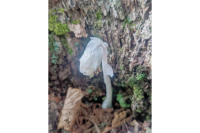It’s the ‘other information’ that makes almanacs interesting
 Now is the time to make resolutions, order seeds for the coming year’s garden and buy an almanac for 2015. Just doing those things will make you feel better.
Now is the time to make resolutions, order seeds for the coming year’s garden and buy an almanac for 2015. Just doing those things will make you feel better.
My almanac of choice this year is titled “Harris’ Farmer’s Almanac for the use of farmers, planters, mechanics and all families for the year of our Lord 2015 being the first year after the bissextile, or leap year, and until the Fourth of July, the 237th year of American Independence containing the astronomical calculations for Northern, Southern and Middle States, weather forecasts, planting tables and a variety of matter useful and entertaining.”
I picked it up in the magazine section of the Ingles store here in Bryson City. My checkout person didn’t have anything to say while ringing up my cheese, ground turkey, pasta, crunchy peanut butter, blackberry jam, or Red Hook beer, but when she happened upon the almanac, she said:
“You believe in that stuff?”
“Absolutely,” I said.
“How can they predict the weather so far ahead of time?” she said.
Related Items
“Beats me,” I said. “Did you know that the first printed almanac was published in 1475?”
“No,” she said. “Debit or credit?”
Actually, I don’t ever look at the weather predictions or follow the seed-planting advice. But late at night when I can’t get to sleep an almanac provides just the sort of reading material you need. Modern-day almanacs are of several types. The traditional survives in the Old Farmer’s Almanac, which has been continuously published in the United States since 1792. But the best-known type is now a vast compendium of statistical, historical and other information. It’s the “other information” that interests me.
Did you know that the term “Dead Man’s Hand” refers to the cards Wild Bill Hickok was supposedly holding when Jack McCall shot him at Nuttal & Mann’s Saloon in Springfield, Missouri?
Did you know that “The southern Argentine region of Patagonia takes its name from mythical human giants, but real giant dinosaur fossils have been found there? The largest is named Argentinosaurus. His nickname is “Argie.” The skeletal restoration displayed at Dr. Coria’s Museum in Patagonia measures 130 feet in length. It’s estimated that “Argie” weighed somewhere between 60 and 110 tons when he roamed the earth about 95 million years ago.
Did you know that “The Grand Hotel on Mackinac Island, Michigan, boasts the longest porch in the world at 660 feet in length”?
Did you know that the first transcontinental telephone line — stretching from New York to San Francisco — required 130,000 poles? Or that the hole for the last pole was dug in Wendover, Utah, in 1913?
Did you know that the primary ingredient in “funeral pie” is raisins because — unlike fresh fruit — they were available year-round?
Did you know that the Library of Congress is the largest institution of its kind in the world, containing “158-million items stored on 838 miles of of bookshelves, 36 million books written in 470 foreign languages, the papers of 23 presidents, including George Washington’s, 3.5 million recordings, 13.7 million photographs, 5.5 million maps, 6.7 million pieces of sheet music, and 69 million manuscripts”?
And so on — exactly the sort of “other information” one is looking for when suffering from insomnia late at night.
George Ellison wrote the biographical introductions for the reissues of two Appalachian classics: Horace Kephart’s Our Southern Highlanders and James Mooney’s History, Myths, and Sacred Formulas of the Cherokees. In June 2005, a selection of his Back Then columns was published by The History Press in Charleston as Mountain Passages: Natural and Cultural History of Western North Carolina and the Great Smoky Mountains. Readers can contact him at P.O. Box 1262, Bryson City, N.C., 28713, or at This email address is being protected from spambots. You need JavaScript enabled to view it..













